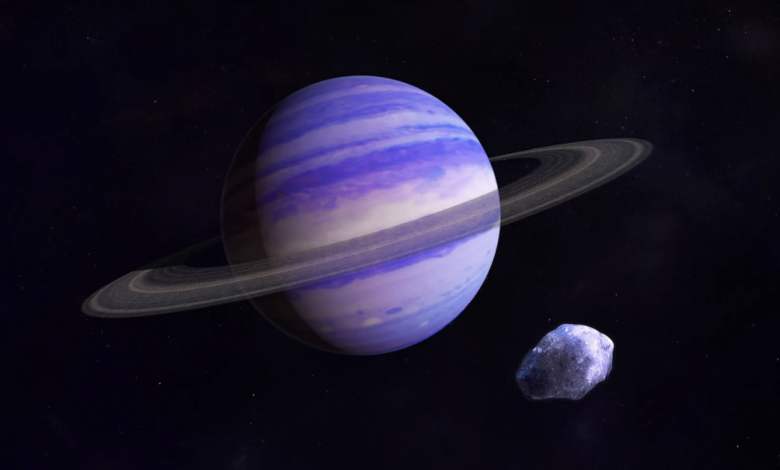Alien planets might teem with purple — yes, purple — life

In deep space, Earth-like worlds could be purple.

A conception of a purple exoplanet.
Credit: NASA
NASA has already spotted a diversity of rocky, Earth-like worlds in the cosmos. But unlike our verdant planet, many of these worlds may flourish with purple life — if life exists out there, that is.
It’s easy to imagine organisms elsewhere resembling the colors of trees, algae, grasses, and beyond that dominate our Earthly reality. This green life soaks up certain light waves from the sun to fuel energy-creating photosynthesis, and the green-pigmented compound chlorophyll helps drive this profoundly successful process. New research from astrobiologists and microbiologists, however, suggests life elsewhere may likely make energy with different types of light from the sun, and use compounds with purple pigments rather than green.
It’s not a far-fetched idea. After all, some microbes on Earth are purple. It’s just that on Earth, in our now oxygen-rich environment, green life (using “oxygenic photosynthesis”) has prevailed in most ecosystems.
“But that doesn’t have to be the case on other planets,” Lígia Fonseca Coelho, a microbiologist at Cornell University’s Carl Sagan Institute who led the research, told Mashable.
The research was recently released in the peer-reviewed science journal Monthly Notices of the Royal Astronomical Society. A major goal was to show how space observatories could — and should — look for the telltale signs of purple life when observing distant planets beyond the sun, called exoplanets. Extremely powerful, forthcoming telescopes, such as the Extremely Large Telescope in the lofty Chilean mountains and the Habitable Worlds Observatory (which would orbit in space), will look into the atmospheres of such far-off worlds and determine their composition and habitability.
“Stop just looking at the green. Look at the purple as well.”
The scientists plucked over 20 purple-colored bacteria from different ecosystems, such as lakes and marshes in Massachusetts and New York, measuring their vibrant pigments and how they give off light. Then, they simulated the “light signatures” — the unique color and chemical fingerprints that would be visible in an alien planet’s reflected light — and found these purple bacteria would generate vivid, identifiable signatures.
Mashable Light Speed
“Stop just looking at the green. Look at the purple as well,” Coelho emphasized. “We could miss a sign of life because of our bias.”

Lígia Fonseca Coelho holding a sample filled with purple-pigmented bacteria.
Credit: Ryan Young / Cornell University

A NASA conception of an Earth-like exoplanet.
Credit: NASA Scientific Visualization Studio
Purple life might not simply exist. It might even be common.
The most abundant stars in our Milky Way galaxy are small red stars, called red dwarf stars. (The closest star to Earth is a red dwarf called Proxima Centauri.) They’re just a fraction of the sun’s size, and are the coolest stars in temperature. Accordingly, most of the light a red dwarf gives off is lower-energy (in infrared or red lightwaves), so any nearby organisms will likely need to use this infrared light (which is invisible to our eyes) to power their cells. “If life exists on the planet, it will use that [infrared] energy instead,” Coelho explained. Crucially, on Earth, purplish bacteria thrive in these lower-energy environments.
On a planet where green microbes and organisms couldn’t survive, or aren’t best suited to survive, purple-pigmented alien life could outcompete them, and come to dominate.
“It might be that Earth was purple.”
It’s even possible that such purple bacteria once flourished on an early Earth. After all, our planet has only had oxygen for about half of its 4.5-billion-year lifespan. There was a time before green, oxygen-emitting, photosynthesizing plants blanketed the world. Different bacteria, surviving on different chemical processes, may have thrived.
“It might be that Earth was purple,” Coelho said.

Mark is an award-winning journalist and the science editor at Mashable. After communicating science as a ranger with the National Park Service, he began a reporting career after seeing the extraordinary value in educating the public about the happenings in earth sciences, space, biodiversity, health, and beyond.
You can reach Mark at [email protected].
This newsletter may contain advertising, deals, or affiliate links. Subscribing to a newsletter indicates your consent to our Terms of Use and Privacy Policy. You may unsubscribe from the newsletters at any time.

